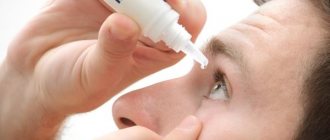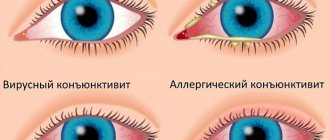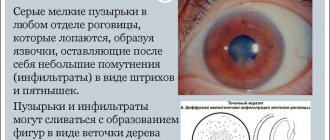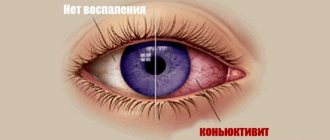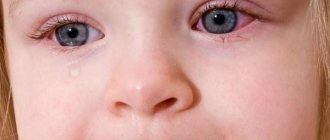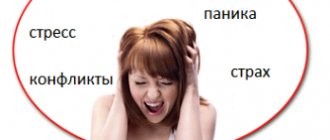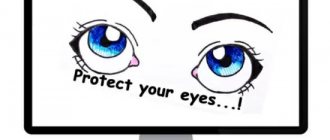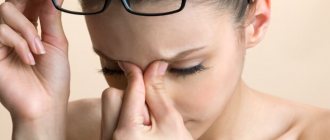What is eye pressure?
There is a constant movement of fluid in the eyes, which is delivered to the eye cornea and later flows away.
If this process of outflow and inflow of fluid is disrupted, then increased or decreased eye pressure is noted. It is necessary to respond to such a pathology immediately, since a deviation from the normal values of this index can lead to complete blindness. Increased intraocular pressure must be treated promptly, only then is it possible to completely get rid of the disease. There are medications that can help bring this indicator back to normal.
The causes of the pathology often lie in external factors, when a person himself provokes high eye pressure. However, there are cases where such a problem occurs due to the influence of another ailment. Only an ophthalmologist can determine the true factors affecting fundus pressure.
Non-pathological reasons:
- Eye injuries. When injuries occur, the drainage channel is blocked, after which symptoms of high eye pressure appear. Bleeding that occurs after injury to the inner lining of the eye is the cause of this.
- Poor nutrition. When consuming salt in large quantities, a person experiences fluid retention in the body; in addition, this situation is often provoked by alcoholic drinks. Congestion directly affects the level of pressure in the eyes.
- Inflammatory eye diseases. Doctors often diagnose a patient with uevitis, a disease that blocks the drainage canal, which causes high eye pressure in women and men of all ages.
- Excessive physical activity. With strong physical activity, intraocular pressure increases, which is considered normal and normalizes on its own when the person rests.
- Primary glaucoma. This disease itself can cause increased eye pressure, but glaucoma can also be the reason why this index has become high. These two ailments can be interrelated in adults.
- Nervous disorders and sleep disorders. Insomnia and nervousness can negatively affect the visual organ, which will be expressed by a high pressure index.
- Medications. A doctor, when examining a patient who has symptoms of high eye pressure, will find out what medications this person is taking on a regular basis. There are certain medications that affect this index. Glucocorticoids and antidepressants can worsen visual function and the condition of the eyes themselves.
- Staying at the computer for a long time. When watching TV for a long time or sitting at a computer monitor for a long time, stagnation of eye fluid will occur, which will increase the level of pressure in the eyes.
This condition may cause an increase in this index, so it is important to undergo a thorough examination before prescribing therapy. Fluid retention in the body is the main factor provoking this disease.
Pathological reasons:
- diabetes;
- diseases of viral origin;
- hypertension;
- hypotension;
- migraine;
- cataract;
- glaucoma.
In addition, kidney diseases and problems in the cardiovascular part of the body also affect intraocular pressure, the symptoms of which people often confuse with manifestations of other pathologies.
Why does my head hurt when my blood pressure is low?
With a normal level of cerebrospinal fluid, intracranial pressure ranges from 3 to 15 mm Hg. Art. Biological fluid performs a protective function, provides brain cells with nutrition, and regulates homeostasis.
When blood pressure is impaired, the circulation of cerebrospinal fluid is disrupted, which provokes an increase in intracranial pressure. This condition is accompanied by stabbing or shooting pain in the eyes. The following factors can cause fluctuations in blood pressure and ICP:
- hypertonic disease;
- hypoxia;
- head injuries;
- tumor development;
- side effects of medications;
- circulatory disorders;
- alcohol poisoning.
Low blood pressure can cause a person no less trouble than high blood pressure. Sometimes persistent arterial hypotension is a physiological feature of the body. For example, it is observed in very active young people or people with underweight and does not cause them any particular inconvenience.
In most cases, the condition still requires diagnosis and drug intervention. With pathologically low blood pressure, weakness and headache appear, which reduces a person’s quality of life. Another phenomenon can lead to the development of a number of complications that are dangerous to the health and life of the patient.
Symptoms
Signs of high pressure in the eyes may not appear at all if the tonometer reading is slightly higher than normal. Indicators that vary between 17-27 mm Hg are considered normal. pillar If this index is significantly higher, then the person will experience very unpleasant sensations similar to the symptoms of hypertension.
Manifestations:
- intense headache, most often manifested in the temporal region;
- pain when moving the eyeballs;
- decreased performance due to constant fatigue;
- inability to read small print or watch television;
- redness of the eyes;
- blurred vision;
- pain and heaviness in the eyeballs.
If increased eye pressure is observed for a long time, then it becomes difficult for a person to work and perform normal activities.
The symptoms can be painful; severe headaches prevent one from living normally. Such manifestations serve as a signal to immediately visit an ophthalmologist, because the situation is becoming dangerous.
We must not forget about the decline in this indicator. If intraocular pressure, the symptoms of which are practically not felt, is less than normal, then the signs are difficult to see. In such people, the eyeballs noticeably sink, since the level of fluid washing the cornea is reduced. Relatives notice that the patient’s eyes have become dull and the vibrant shine has disappeared. A long period of low eye pressure can lead to atrophic changes in the tissue of this organ, and, as a result, to a complete loss of visual function.
Symptoms and treatment of this pathology can be different, and if the disease progresses, then its signs will be brighter and therapy more complicated. If you identify the disease at an early stage, it is much easier to eliminate it; an advanced stage of the disease can seriously impair vision, and treatment will be long and not always effective.
Eyes hurt, as if there is pressure
It puts an incredible strain on the eyes. Especially today, in the age of digital technology, when, if we are not looking at a computer monitor at work, we are reading an e-book or “surfing the Internet” on a smartphone, or even watching TV programs until late. No wonder your eyes get tired. In some cases, pressing pain occurs. What this is connected with and how to get rid of it, we will talk in more detail below.
Intraocular hypertension
Everyone knows what arterial hypertension is, but few have encountered the concept of increased intraocular pressure. This concept refers to the pressure that is exerted on the shell of the eye by the vitreous body and the fluid located inside the organ of vision. The pressure inside the eye can increase due to a variety of diseases:
- Ÿ acute respiratory infections, ARVI, influenza;
- Ÿ migraine;
- Ÿ headache;
- Ÿ endocrine diseases;
- Ÿ glaucoma;
- Ÿ inflammatory process of the organs of vision and others.
Diagnostics
Treatment of eye pressure cannot be carried out without diagnostic measures. Only by identifying the causes and manifestations can the correct therapy be prescribed to such a patient. There are several ways to measure this index, because without accurate indicators, an ophthalmologist will not be able to select pills for this disease.
Measurement methods:
- Palpation. Not all doctors can use this technique in practice, since you need to know the features of such a measurement. The doctor sits the patient with his back to himself, asks him to look down at the floor and close his eyes in this position. The specialist presses his finger on the patient’s eyes, finding out how elastic they are. If the elasticity is strong, then increased eye pressure is noted; if the elasticity is weak, this indicator is lower than normal.
- Measurement using a Maklakov tonometer. This tool is light in weight, about 5-15 grams and consists of 2 cylinders with a flat bottom. The patient lies down on the couch, and the doctor covers the bottom of the instrument with special paint, having previously treated the eyeball with an anesthetic substance. The cylinder is placed on the open eye, the cornea itself, and released. Afterwards, the doctor removes the instrument and makes an imprint of the painted bottom on a piece of paper. There is a special measuring scale that determines increased or decreased eye pressure.
- Measurements using a pneumotonometer. This device is a modern means of measuring eye pressure readings. The patient sits on a chair in front of the doctor with his eyes wide open, and the doctor directs a stream of compressed air into the eyeball, directly into the center of the cornea. The device immediately provides the result of such a measurement, and no anesthesia is required.
Today, the measurement of this indicator using a tonometer is not carried out in all medical institutions, due to the cost of this instrument. There are several other ways to obtain such data, but they are used less frequently.
Treatment
Only an ophthalmologist knows how to treat eye pressure; you should not take medications without a prescription from a specialist, this can only worsen the situation. Drug therapy for this disease is considered ineffective or is used at the preliminary stage of treatment.
Today, drops are considered effective for eye pressure. With the help of this medicine, you can eliminate any problems such as a decrease or increase in the index. In addition, these medications help stop the development of glaucoma. Doctors divide the drops they use into several types.
Types of medications:
- Means that help slow down the formation of excess fluid in the internal tissues of the eye.
- Drugs that can increase the outflow of ocular fluid.
- Combination medications.
Eye pressure drops not only help reduce this indicator, but also nourish the tissues of this visual organ and improve vision.
Types of drops
| Type of medicine | Action | Side effects |
| Beta blockers | Allows you to reduce the production of eye fluid. The therapeutic effect occurs half an hour after application to the eyeball. | Decreased heart rate, bronchospasm. |
| Cholinomimetics | They increase the outflow of fluid by contracting the eye muscles. | Pain in the temples, forehead, eyebrows. Constriction of the pupils. |
| Carbonic anhydrase inhibitors | Reduce the synthesis of ocular fluid. | Use with caution in people with renal pathologies. |
| Prostaglandins | Increase the outflow of fluid in the internal tissues of the eyes. The therapeutic effect occurs 2 hours after application. | Redness of the eyes, active growth of eyelashes. |
In addition to pharmaceutical drugs, there are folk remedies for eye pressure, but they must be used extremely carefully and only after consulting a doctor.
Solutions to the problem
What should you do if you constantly feel pressing pain in your eyes, and an examination confirms the diagnosis: increased intraocular pressure? At the initial stage of the problem, when serious dysfunction of the eyeballs has not yet been recorded, simple methods can help. These include gymnastic exercises for the eyes, drops with a moisturizing effect and wearing protective glasses so as not to overload the pupils. At the same time, it is necessary to control the time spent in front of a computer monitor or TV.
Medications that are used to eliminate signs of intraocular pressure:
- Carbanhydrase inhibitors - Azopt, Trusopt, are prescribed by an ophthalmologist to reduce the production of intraocular fluid, but have a number of side effects (burning and redness of the eyes, unpleasant taste in the mouth).
- Prostaglandins - Travatan, Xalatan, Taflotan, are designed to enhance the outflow of excess fluid from the eyes; side effects include darkening of the iris and active growth of eyelashes.
- Beta blockers - Timolol, Betaxolol, are often prescribed simultaneously with prostaglandins and help reduce the production of intraocular fluid; they are contraindicated in patients with diabetes mellitus and pulmonary pathologies.
- Miotics - the most common drug for contracting the pupil and reducing the production of intraocular fluid is Pilocarpine.
- Combined means. One of them is Proxofelin, it increases the outflow of fluid from the eyes and alleviates the symptoms of increased intraocular pressure.
Doses of drugs are determined by the attending physician, and an individual therapy program is also drawn up, depending on the clinical symptoms and stage of the disease. With regular treatment and following medical recommendations, the pressing pain in the eyes goes away and vision is restored. Treatment of intracranial hypertension with medications is also carried out at the stage when lifestyle changes are no longer able to eliminate the symptoms of the pathology.
Among the medications for the relief of ICP, the following are distinguished:
- Diuretics - stabilize intracranial pressure and improve the removal of excess fluid from the body, these are Veroshpiron and Furosemide.
- Nootropic drugs - improve the supply of brain tissue with vitamins and nutrients, improve the supply of oxygen. Pantogam, Piracetam, Cavinton are recommended for use.
- Stimulators of brain neurons - calm and improve the functioning of the organ; the drugs Nervohel and Glycine are considered effective.
- B vitamins and sedatives - to improve the functions of the nervous system, eliminate increased nervousness and irritability.
To reduce high intracranial pressure and eliminate pain in the eyes, it is necessary to identify the root cause of the symptoms. If necessary, cardiologists, neurologists, pulmonologists and other specialists join the treatment.
Auxiliary procedures
To reduce the symptoms of pain and discomfort in the eyes, patients with different diagnoses (intracranial and intraocular pressure) need to reconsider their lifestyle. Such physiological methods, without the use of drugs, are suitable for stopping diseases at the initial stage. First of all, you need to give up bad habits and follow a diet. You should give up salty, fatty foods, replacing them with fiber, proteins, and plant foods (vegetables and fruits).
An additional therapy program includes limiting the volume of water drunk to 1–1.5 liters per day for low production of cerebrospinal and intraocular fluid, walking in the fresh air in the evenings to saturate the brain with oxygen, providing air in the living room (ventilation and sleeping with an open window), creating moderate physical activity - swimming, jogging, walking to maintain normal muscle tone and strengthen blood vessels.
It is necessary to eliminate stress factors and prevent excessive psycho-emotional stress. It is important to provide the body with proper rest at night, lasting at least 7–8 hours in a row. Additional physiotherapy procedures include ozokerite or paraffin wrap, SMT, electrophoresis, ultrasound and magnetic therapy. A general massage or treatment of the collar area is indicated for better drainage of fluid from the tissues.
Whatever the reasons for the feeling of pressing pain in the eyes, migraine, chronic fatigue, overstrain of the eyeballs or increased intracranial and intraocular pressure, the symptom should not be ignored. Without proper treatment, regular exacerbations can lead to loss of vision, mental disorders, chronic arterial hypertension, stroke and other dangerous complications.
Folk remedies
With the help of folk remedies, you can not only stabilize the pressure in the eyes, but also replenish the body’s vitamin reserves, as well as improve metabolism.
Facilities:
- Rinse with aloe juice. Prepare a solution of 6 crushed aloe plant leaves and a glass of boiling water, pour over the leaves and boil for 5-6 minutes. Cool and wash the eye area with the resulting product 5-7 times a day. Make a course of such therapy lasting 2 weeks, after which you need a break for the same period.
- Tomato juice. Drink this delicious medicine 1/4 cup at a time, 4-5 times a day. The course of treatment is 21 days, after which you need to take a break and start therapy again.
- Honey and celandine. Take both ingredients in equal parts, mix and cook until thick. Leave to cool and apply this product on a napkin to your eyes.
- Nettle and lily of the valley flowers. For the infusion you will need 1 glass of crushed nettle and 2 small spoons of lily of the valley flowers. Mix the ingredients and add 2 cups of water at room temperature. Leave to steep overnight. In the morning, add 2 teaspoons of baking soda to the mixture. Use the product as an eye lotion.
The list of folk recipes for this disease is huge, but you need to carefully analyze the effect of the components of such home remedies.
What to do if you have high intraocular pressure? Only professional help is needed for such patients; it is not worth solving this problem on your own. After consulting a doctor, it will become clear to a person what medications he needs and what folk remedies can alleviate his condition.
How to eliminate pain in the head and eyes?
Thanks to the symptoms, it is possible to roughly determine why a person experiences pressure on the eyes during a headache. But only a doctor can make an accurate diagnosis and recommend drug treatment. At home, it is better for the patient to supplement treatment by regularly performing eye exercises, as well as using safe traditional methods of treatment
Drug treatment
Complex therapy prescribed by a doctor is aimed at relieving headaches, eye pressure and eliminating the cause that led to discomfort. The following medications may be prescribed:
- Painkillers . These can be analgesics: Analgin, Pentalgin and non-steroidal anti-inflammatory drugs: Ibuprofen, Nurofen, Diclofenac.
- Diuretics. They help normalize the outflow of fluid if pressing pain in the eyes appears due to increased intracranial pressure. The doctor may recommend taking Diacarb, Furosemide.
- Antibiotics. They are used if it is determined that the disease accompanied by headaches is caused by bacterial pathogens. The choice of antibacterial drug depends on the doctor, who can take a swab from the eye and nose for culture. Erythromycin ointment is prescribed for the eyes, Amoxicillin and Cephalexin are prescribed for oral tablets.
- Antidepressants, sedatives, tranquilizers. Drugs in this group must be taken if pain in the head and eyes occurs due to stress, nervous tension, or depression.
A separate group of medications should include eye drops, which an ophthalmologist prescribes when intraocular pressure increases.
- To reduce the production of intraocular fluid, Azopt, Trusot, Timolol, Bitoptik are prescribed.
- To enhance the outflow of intraocular fluid, you need to take Travatan, Taflotan, Xalatan.
- To reduce the inflammatory process, Diclofenac is dripped into the eyes.
- To narrow the pupil and normalize the outflow of fluid, it is necessary to drip Pilocarpine.
If necessary, the patient is prescribed massage, manual therapy sessions, and physiotherapy courses. When drug therapy does not help, the patient is offered to undergo laser or surgical surgery.
Eye exercises
With simple exercises you can reduce the feeling of fatigue, get rid of dry eyes, and eliminate tension. Exercises are carried out every day, and not just at the moment when your eyes begin to hurt. Why does it put pressure on the eyes if you rarely do exercises? The eye muscles are not strengthened, and the exercise does not bring a therapeutic effect. With regular exercise, pain in the eyes and head appears less and less often and may disappear completely. To perform the exercise, the patient needs to sit on a chair and relax.
- Movements with open eyes up and down, 6 times, then closed.
- Without moving your head, look left and right 6-8 times. Close your eyes and repeat the movements.
- Starting from the upper right corner of the room, draw an imaginary circle with your eyes, then in the middle of the room - a circle, a triangle. Repeat with eyes closed.
- Make a movement that draws a “figure eight”, “infinity sign”, with your eyes open and closed.
- Drawing spiral curls towards yourself, away from you, to the side.
Exercise won't help if you do it occasionally.
Exercises are contraindicated in case of acute inflammatory process affecting the brain, eyes, high temperature, injury to the eyes or face.
Traditional medicine recipes
When choosing how to treat a headache and eliminate discomfort in the eyes, it is necessary to first determine why the pain appeared. Below are the simplest recipes that help relieve discomfort for a certain period.
- Eye lotions. Relieves swelling with increased intracranial and intraocular pressure. For the lotion, first prepare an infusion of medicinal herbs: nettle, lily of the valley, chamomile. 2 tbsp. spoons of dry raw materials are poured with boiling water, infused until cool, and filtered. Gauze or bandage folded in several layers is moistened in the decoction and applied to the eyes. The liquid should be at room temperature. The procedure takes 5-10 minutes. After several procedures, the pressing pain in the eyes becomes less.
- Eye wash. It is produced with medicinal solutions: based on tea infusion, chamomile decoction, golden mustache, aloe. Dip a cotton pad into the broth and squeeze it out lightly. Rinsing should be done from the outer corner of the eye to the inner corner, so that the liquid not only washes the eyelid, but also gets onto the mucous membrane of the eye. The procedure is performed at least four times a day.
- Taking decoctions internally. To relieve the pain of tension and alleviate a migraine attack, tea with mint and lemon balm is taken orally. Clover infusion helps relieve discomfort caused by increased intraocular pressure.
To ensure that pain in the eyes no longer bothers you, you need to use all treatment methods in combination: take medications, carry out procedures offered by traditional medicine and perform exercises that strengthen the eye muscles.
To eliminate headaches, you can take a painkiller, take a cool shower, or do a relaxing head and neck massage.
